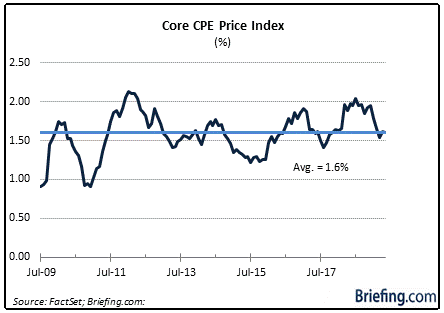It happened. It finally happened. The FOMC cut the target range for the fed funds rate for the first time since 2008. That decision came less than eight months after the FOMC stated that they would continue to roll off their balance sheet and tighten interest rates so as to not disrupt the economy all while maintaining “data dependence.” Less than eight months later and we find ourselves in a 180 degree U turn. This decision is being considered to be a solution, but it could just end up being a problem.
Many credible individuals debate whether or not a cut was at all necessary. As a matter of fact, Yale professor and Nobel-prize winning economist Robert Shiller made an argument why economic and financial conditions justify a rate hike at the July meeting.
The decision was made to reduce the target range for the fed funds rate by 25 basis points to 2.00% to 2.25%. It wasn't a unanimous decision. Boston Fed President Rosengren and Kansas City Fed President George dissented, stating a preference to leave the policy rate unchanged. The consensus was decided on with response to the global developments for economic outlook and subdued inflation.
The Fed believes that they can inflate the inflation rate by lowering interest rates. This is a belief that is taught in the textbooks. In practice however, both Japan, and the EU have struggled to implement this strategy into results. Rates in both those areas have been negative for quite some time and yet inflation remains tempered.
Domestically, PCE inflation in the U.S. has failed to run above 2.0% on a sustained basis over the last ten years when the target range for the fed funds rate was lower -- and even much lower -- than it is today.
Regardless, the Fed is going back to the drawing board, and the ECB looks ready to do the same soon with further policy accommodation -- and with that comes a set of problems.
What’s the Point?
Currently, the 10-year note yields in Belgium, Denmark, France, Germany, the Netherlands, Sweden, and Switzerland are all negative already and would slide further into negative territory with further policy accommodation.
Treasury market participants aren't blind to the possibility. If anything, U.S. Treasury market has been the target of EU bond investors as they flock to chase higher yields.
Why’s that a Problem?
On its own, the above is not a problem. However, that sort of behavior is driving market rates lower in the U.S. and forcing a flattening/inversion of the Treasury yield curve that isn't terribly conducive for bank lending activity. That flattening/inversion can become a problem since a lack of money velocity makes it difficult to produce the economic growth that drives the higher inflation rate that the Fed is shooting for with its lower policy rate.
Secondly, with that sort of action/behavior, inflation expectations could remain in check. Furthermore, an expectation that market rates will be moving lower in the U.S., because of the negative rates abroad, could stall borrowing as debtors refrain from seeking new credit on an assumption that they can do so later at lower borrowing rates. Simply put, the expectation that an individual can borrow in six, seven, twelve months down the line for a lower rate will dampen the interest for that individual to borrow today.
The Fed may be aiming to boost inflation and steepen the yield curve with lower policy rates, but it could all be for naught since market rates here are at risk of further deflation due to the negative rates abroad. And that could be a big problem for the Fed.
I Seent It
Low interest rates are supportive for risk assets like stocks. So this issue might not be a fundamental problem for the stock market at first.
Every Treasury security from the 6-mo bill to the 10-yr note is currently yielding less than the S&P 500 dividend yield (2.04%). That “should” create added appeal to own stocks over these other securities. However, the persistence of low rates is a driver for stock premium.
At the end of 2018, the forward 12 month PE for the SPX500 was around 14.2x. Today, with no earnings growth in the first half of the year, the SPX500 trades at 16.9X forward 12 month. That multiple has expanded as the risk-free rate has come down -- way down.
Get to Know TINA
If you aren’t familiar, get to know the term TINA moving forward. No this is not a girl you can take out at some point, this is an acronym for “There Is No Alternative.” TINA refers to a perception that groupthink investors and managers will adopt when rates keep falling. This has, and most likely will, increase the multiple expansion of stocks. In layman terms, the lower interest rates go, the higher the stock multiples can get. (Bubblenomics)
The risk with the Fed's current policy stance is that it fails to produce the growth the Fed expects. You sometimes hear that the Fed might be "pushing on a string" lowering rates now when it is running up against offsetting influences like trade uncertainty, Brexit uncertainty, and structural forces like an aging population and low birth rates. The problem is that if the systemic forces that the Fed is attempting to battle are greater than a slight reduction in rates the impacts of those cuts will be offset, greatly, by this greater risk.
The second set of issues is a set of circumstantial problems alerted specifically by Powell himself. The FOMC is facing headwinds from trade and these issues are not customary to what the Fed is accustomed to. In his words, the Fed is required to tread lightly as they are not accustomed to this type of risk.
The last, and most basic, set of circumstances to worry about is if general price inflation gets going and exceeds the inflation target on a sustained basis, it doesn't take much to think how the Fed would aim to control that. It would raise the fed funds rate. This would create yet a new set of problems for a market that has thrived off of low rates and increasing multiple expansion.
Should inflation continue to be dampened however, get used to TINA. Investors will keep passing her name around suggesting to you that there is no other alternative than to own stocks. The problem with TINA is that as this idea starts to gain momentum it will only exacerbate the problem for the market if/when things come to a screeching halt. This doesn't mean the end is necessarily near for the bull market. It just means that the end, when it comes, could be a bigger problem for the market and the economy than it would be currently given the Fed’s actions and attempts.





